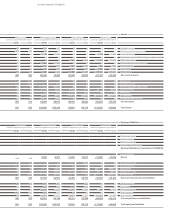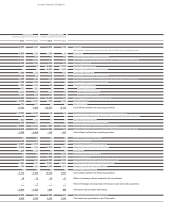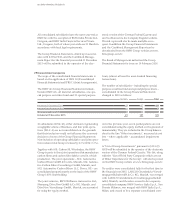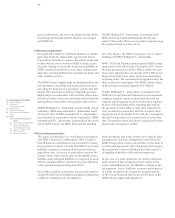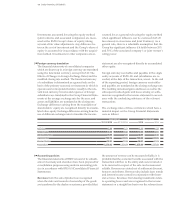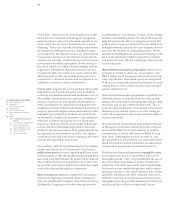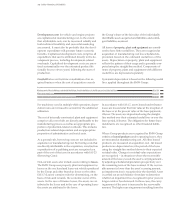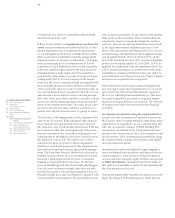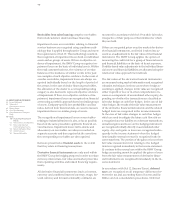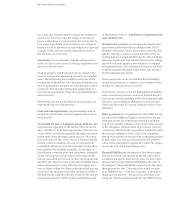BMW 2015 Annual Report Download - page 102
Download and view the complete annual report
Please find page 102 of the 2015 BMW annual report below. You can navigate through the pages in the report by either clicking on the pages listed below, or by using the keyword search tool below to find specific information within the annual report.
102
of the lease. Interest income from finance leases and
from customer and dealer financing are recognised
using the effective interest method and reported as
rev-
enues within the line item “Interest income on loan
finan cing”. If the sale of products includes a determina-
ble amount for subsequent services (multiple-
compo-
nent contracts), the related revenues are deferred and
recognised as income over the relevant service period.
Amounts are normally recognised as income by reference
to the pattern of related expenditure. Profits arising on
the sale of vehicles for which a Group company retains a
repurchase commitment (buy-back contracts) are not
recognised until such profits have been realised. The
difference between the sales and buy-back price is
ac-
counted for as deferred income and recognised in in-
stalments
as revenue over the contract term.
Cost of sales comprises the cost of products sold and the
acquisition cost of purchased goods sold. In addition
to directly attributable material and production costs, it
also includes statutory and non-statutory warranty ex-
penses, research costs, non-capitalised development
costs, amortisation on capitalised development costs,
production-related overheads (including depreciation of
property, plant and equipment and amortisation of other
intangible assets relating to production), write-downs
on inventories, freight and insurance costs relating to
deliveries to dealers and agency fees on direct sales.
Expenses which are directly attributable to financial
services business (including depreciation on leased
products), the interest expense from refinancing the
en-
tire financial services business as well as the expense
of risk provisions and write-downs relating to such busi-
ness are also reported in cost of sales.
In accordance with IAS 20 (Accounting for Government
Grants and Disclosure of Government Assistance),
public sector grants are not recognised until there is rea-
sonable assurance that the conditions attaching to them
have been complied with and the grants will be received.
The resulting income is recognised in cost of sales over
the periods necessary to match them with the related
costs which they are intended to compensate.
Basic earnings per share are computed in accordance
with IAS 33 (Earnings per Share). Basic earnings per
share are calculated for common and preferred stock by
dividing the Group net profit after minority interests,
as attributable to each category of stock, by the average
number of outstanding shares. The net profit is accord-
ingly allocated to the different categories of stock. The
portion of the Group net profit for the year which is not
being distributed is allocated to each category of stock
based on the number of outstanding shares. Profits
available for distribution are determined directly on the
basis of the dividend resolutions passed for common
and preferred stock. Diluted earnings per share are dis-
closed separately.
Share-based remuneration programmes which are ex-
pected
to be settled in shares are, in accordance with
IFRS 2 (Share-based Payments), measured at their fair
value at grant date. The related expense is recognised
in the income statement (as personnel expense) over the
vesting period, with a contra (credit) entry recorded
against capital reserves.
Share-based remuneration programmes expected to be
settled in cash are revalued to their fair value at each
balance sheet date between the grant date and the settle-
ment
date and on the settlement date itself. The
ex-
pense for such programmes is recognised in the income
statement (as personnel expense) over the vesting pe-
riod of the programmes and recognised in the balance
sheet as a provision.
The share-based remuneration programme for Board
of Management members and senior heads of depart-
ment entitles BMW AG to elect whether to settle its
commitments in cash or with shares of BMW AG
com-
mon stock. Following the decision to settle in cash,
this
programme is accounted for as a cash-settled share-
based transaction. Further information on share-based
remuneration programmes is provided in note 19.
Purchased and internally-generated intangible assets
are recognised as assets in accordance with IAS 38
(Intangible Assets), where it is probable that the use of
the asset will generate future economic benefits and
where the costs of the asset can be determined reliably.
Such assets are measured at acquisition and / or
manu-
facturing cost and, to the extent that they have a finite
useful life, amortised over their estimated useful lives.
With the exception of capitalised development costs,
intangible
assets are generally amortised over their esti-
mated useful lives of between three and 20 years.
90 GROUP FINANCIAL STATEMENTS
90 Income Statements
90 Statement of
Comprehensive Income
92 Balance Sheets
94 Cash Flow Statements
96 Group Statement of Changes in
Equity
98 Notes
98 Accounting Principles and
Policies
113 Notes to the Income Statement
121 Notes to the Statement
of Comprehensive Income
122
Notes to the Balance Sheet
147 Other Disclosures
163 Segment Information



